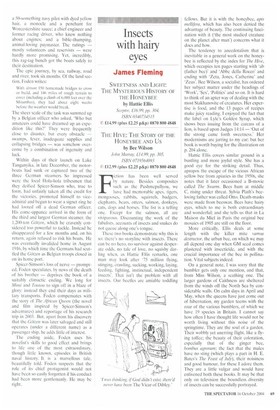Insects with hairy eyes
James Fleming
SWEETNESS AND LIGHT: THE MYSTERIOUS HISTORY OF THE HONEYBEE by Hattie Ellis Sceptre, £16.99, pp. 304. ISBN 0340734515 rt.) £14.99 (plus £2.25 p&p) 0870 800 4848 THE HIVE: THE STORY OF THE HONEYBEE AND US by Bee Wilson John Mummy, £1-1.99, pp. 305, ISBN 0719564093 ()E12.99 (plus 0.25 p&p) 0870 800 4848 Fiction has been well served hy nature. Besides composites such as the Pushmepullyou, we have had memorable apes, tigers, mongooses, rabbits, squirrels, badgers, elephants, bears, otters, salmon, donkeys, cats, dogs and horses. The list is a telling one. Except for the salmon, all are viviparous. Discounting the work of the fabulists, accounts of insects and snakes do not queue along one's tongue.
These two books demonstrate why this is so: there's no storvline with insects. There Can be no hero, no survivor against desperate odds, no tale of love, no squishy darling when, as Hattie Ellis remarks, one man may look after '75 million flying, stinging, crawling, sucking, working, laying, feeding, fighting, instinctual, independent insects', That isn't the problem with all insects. Our beetles are amiable toddling
fellows. But it is with the honeybee, apis mellifera, which has also been denied the advantage of beauty. The continuing fascination with it (`the most studied creature on the planet after man') concerns what it does and how.
The tendency to artecdotalism that is inevitable in a general work on the honeybee is reflected by the index for The Hive, which occupies ten pages starting with 'ab (father bee)' and 'Abbe della Rocco' and ending with 'Zeta, Jones, Catherine' and 'Zeus'. Bee Wilson, a socialist, has ordered her subject matter under the headings of 'Work', 'Sex', 'Politics' and so on. It is hard to think of an apter way of dealing with the most Stakhanovite of creatures. Her expertise is food, and the 13 pages of recipes make juicy reading. I enjoyed the fact that the label on Lyle's Golden Syrup, which shows bees issuing from the carcass of a lion, is based upon Judges 14:14 — 'Out of the strong came forth sweetness.' Her modernisms are jarring to my ear; but her book is worth buying for the illustration on p. 204 alone.
Hattie Ellis covers similar ground in a bustling and more joyful style. She has a good eye for the striking detail. Thus, apropos the escape of the vicious African yellow bee from apiaries in the 1950s, she notes that it later occasioned a B-movie called The Swarm. Bees hum at middle C, rising under threat. Sylvia Plath's beeloving father was called Otto. Death-masks were made from beeswax. Bees have hairy eyes, which to me is both extraordinary and wonderful; and she tells us that in La Maison du Mid l in Paris the original bee mosaics of 1905 are still on the floor.
More critically, Ellis deals at some length with the killer mite vaffoa destructor, the urban bee, on which we may all depend one day when GM seed comes plastered with insecticide, and with the crucial importance of the bee in pollination. Vital subjects indeed.
On a general note. I was sorry that the bumbler gets only one mention, and that, from Miss Wilson, a scathing one. The larger gardens of Caithness are sheltered from the winds off the North Sea by considerable walls. On calm days in April and May, when the queens have just come out of hibernation, my garden teems with the roar of the various bumblers, of which we have 19 species in Britain. I cannot say how often I have thought life would not be worth living without this noise of the springtime. They are the soul of a garden. Their wobbly yet unerring flight, like a flying toffee; the beauty of their coloration, especially that of the ginger bee, bombus agrorum; the fact that the males have no sting (which plays a part in H. E. Bates's The Feast of July), their noisiness and good humour, for these I adore them. They are a little vulgar and would have enlivened both these books. It may be that only on television the boundless diversity of insects can be successfully portrayed.










































































































 Previous page
Previous page